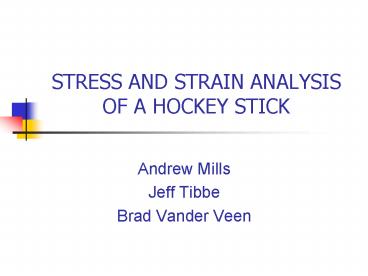STRESS AND STRAIN ANALYSIS OF A HOCKEY STICK PowerPoint PPT Presentation
Title: STRESS AND STRAIN ANALYSIS OF A HOCKEY STICK
1
STRESS AND STRAIN ANALYSIS OF A HOCKEY STICK
- Andrew Mills
- Jeff Tibbe
- Brad Vander Veen
2
Loading Analysis
- Loading is due to stick blade striking the ice
- In bending and torsion
- The stick bends similar to a bow
- Elastic energy stored in the bent stick is used
to accelerate the puck
3
Picture
4
Picture
- The bottom half of the stick looks like a
cantilever beam this is how the load will be
modeled
5
Model of a Hockey Stick
6
Experimental Setup
- Cantilever beam in torsion and bending
- Fixed with clamps at midpoint of shaft
- Mass hung where stick blade would strike the ice
- Strain gage place at fixed end
7
Theoretical Principal Strains
8
Theoretical Principal Stresses
9
Experimental Setup
10
Experimental Setup
11
Experimental Setup
12
Diagram of Rosette
13
Results
14
Experimental Principal Strains
15
Experimental Principal Stress
16
Comparison
- Theoretical and Actual follow the same trends.
- Most results had a percent discrepancy of about
15 to 40 - Torsional stress results did not agree as well as
bending stress results - Angles of principal stresses and strains agreed
(3 vs 5)
17
Failure Analysis
- Hockey stick yielded when a 70 lb load was
applied. - At 60 lbs, the measured maximum principal stress
was 49,000 psi - The yield stress for the material was 52,900 psi
- The 70 lb load caused a principal stress higher
than the yield stress
18
Discussion
- Error in torsional results was higher because it
was hard to constrain it - Measurements were very sensitive to slight
constraint movements
19
Conclusion
- Stresses and strains in a theoretical analysis
agreed well with results found in the actual
experiment
20
Questions?
PowerShow.com is a leading presentation sharing website. It has millions of presentations already uploaded and available with 1,000s more being uploaded by its users every day. Whatever your area of interest, here you’ll be able to find and view presentations you’ll love and possibly download. And, best of all, it is completely free and easy to use.
You might even have a presentation you’d like to share with others. If so, just upload it to PowerShow.com. We’ll convert it to an HTML5 slideshow that includes all the media types you’ve already added: audio, video, music, pictures, animations and transition effects. Then you can share it with your target audience as well as PowerShow.com’s millions of monthly visitors. And, again, it’s all free.
About the Developers
PowerShow.com is brought to you by CrystalGraphics, the award-winning developer and market-leading publisher of rich-media enhancement products for presentations. Our product offerings include millions of PowerPoint templates, diagrams, animated 3D characters and more.

